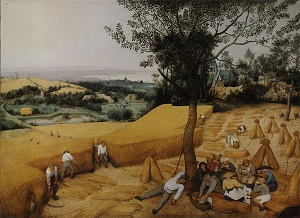
Thousands of years ago, when farming began, it changed the world.
Centuries ago, meat made up about a third of prehistoric peoples' diet. Since they had to follow the herds of animals they hunted, these early people never stayed put in one place, they lived as
nomads
.
So, nomads began farming because they had to follow their food wherever it went during changing seasons. They did not know exactly how to farm at the time, but they eventually adapted to it. Prehistoric farmers collected seeds from wild plants and placed them into the ground using deer antlers and other available resources as tools.
In 7000 B.C.E., farming developed in Central and South America. Clay pots were originally made in Japan in 10500 B.C.E. and eventually made their way to the Near East and Africa where they were used to store grain and water. In 4400 B.C.E. horses were domesticated in Eastern Europe and ridden for the first time.
Farmers learned how to tame wild animals beyond horses and breed them in captivity. The first domesticated animals that appeared on farms were sheep, goats, and pigs, which helped farmers grow wheat and barley. Farms developed in the Near East in 7000 B.C.E. and in Europe, in a region known as the “Fertile Crescent”. Farming then spread throughout Europe and Western Asia and developed independently in the rest of Asia, South America, and North America.
Cave paintings from Tassili in Algeria, from around 10,000 years ago, show that early people also hunted hippopotamuses, giraffes, rhinoceros, and elephants in the Sahara Desert, which was much lusher than it is now. The paintings show farmers tending herds of cattle. In 3000 B.C.E. the Sahara’s climate became much drier. Many of those animals disappeared and were replaced by desert animals like camels and snakes.
Instead of roaming to find enough food to eat, people found they could
grow enough food on small patches of land to feed their families and domesticated animals. Once they realized they could farm as such, they could build houses and settle in one place.
Homes became settlements and clusters of homes became the first villages, which then grew into the first towns. In towns, crops could be harvested and grain was ground into flour, which was then used to make bread.
Farming helped nomads evolve into settlers and grow food year-long. Though farming is common practice now, the practice took centuries for early people to perfect.
[Source:
World History Encyclopedia
]

